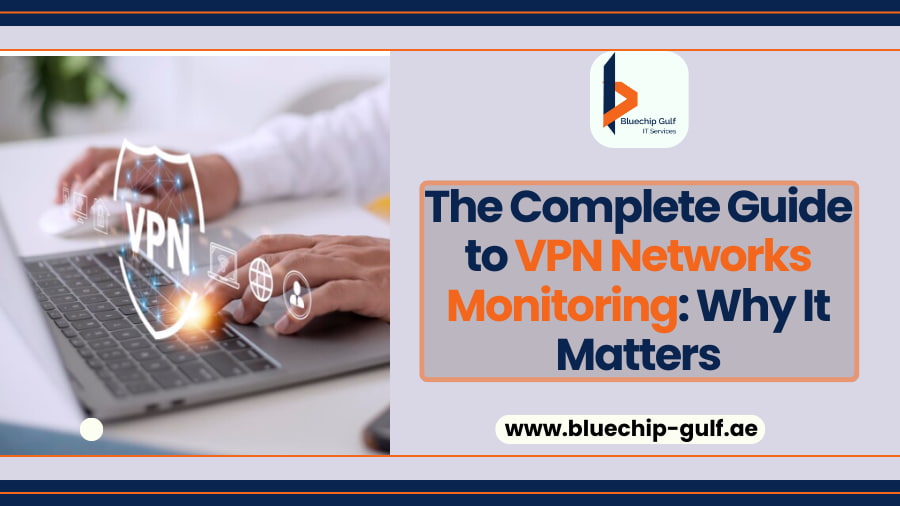
Although SaaS has greatly streamlined digital transformation, VPN Networks Monitoring technology deserves recognition for facilitating remote work. Numerous organizations, regardless of their size, effectively carry out their operations from a distance, undeterred by security concerns, with the help of VPNs.
VPN Networks Monitoring allows private networks to make use of public networks and shared computing resources. Such connections are safeguarded by data encryption that channels data transmissions between a device and a network through a secure medium known as a VPN tunnel. This ensures company data stays contained within their network. Nonetheless, a security vulnerability in your applications, the use of an obsolete operating system, and even inadequacies within your home network could lead to a stark compromise to the security of your VPN.
What is VPN Networks Monitoring?
VPNs can offer a sense of security, but they must be working correctly. Employees rely heavily on VPNs to carry out their designated tasks. IT personnel need to be aware of what equipment, software, and services are being used in conjunction with VPNs and how these systems are running seamlessly. To ensure optimal working conditions, VPN Networks Monitoring is recommended as it allows accurate tracking of the network’s connections, tunnels, and pathways. Through this, KPIs and metrics like latency (connection speed) and tunnel flap (automatic disconnection and reconnection) can be observed and measured, giving teams insight into enhancing system performance. Poor VPN usability results in a reduced end-user experience, whereas a healthy VPN proficiency is critical in obtaining and maintaining a successful business environment.
To ensure smooth and secure data transfer through private networks and proper allocation of bandwidth, VPN Networks Monitoring checks the functioning of various connected VPN devices, monitors VPN traffic, and also observes the maximum consumption of resources by different users through network traffic monitoring.
Why Monitor a VPN?
We can ensure the security of a VPN by overseeing the connections and monitoring the pathway to vigilantly track essential security metrics. This practice also guarantees the inaccessibility of sensitive data to unauthorized parties during transmission. To validate the VPN’s optimal performance, network administrators can additionally monitor the volume of data transmitted via the tunnels, the transmission rate, and other key performance metrics.
How to approach VPN Networks Monitoring
To keep track of VPN accessibility, a basic ICMP ping exam should be conducted. To evaluate the health and execution of a VPN, a monitoring system that supports VPN Networks Monitoring is necessary. The monitoring tool should manage SNMP and provide comprehensive supervision.
If the connection terminates as a result of a line failure or hardware problem or if it remains idle as per security protocols for longer than a designated period, a VPN tunnel may falter, or go inactive. However, supervision of VPN tunnel flaps is critical and SNMP traps are the best method to detect them. While processing, apparatuses transmit instantaneous message alerts to supervisory devices that ultimately send signals to users.
Why is VPN Networks monitoring essential?
Just like the practice of monitoring any network, it is indispensable to assess the operational status of your VPN to ensure the efficacy of your network infrastructure. VPNs are increasingly pivotal for enabling remote work and bridging disparate networks, even when separated by considerable distances. These facets hold critical importance in the operations of contemporary businesses. The surveillance of the VPN ecosystem assumes significance as it aids in comprehending its performance, facilitating enhancements whenever required, with the ultimate goal of delivering an optimized user experience to all stakeholders.
Furthermore, a critical facet of VPN Networks Monitoring revolves around tracking the connections made to the VPN network to ascertain authorized access. The presence of unidentified connection attempts can potentially indicate intrusion attempts. Additionally, dormant accounts of former employees, if not properly deactivated, present a security vulnerability by potentially retaining access to internal resources. Therefore, the implementation of a VPN monitoring system is imperative to identify and address such irregularities before the emergence of security emergencies.
How VPN Monitoring Works
In practical implementation, the monitoring of VPNs is facilitated through the utilization of network monitoring solutions, designed to proficiently oversee the diverse devices engaged in routing VPN traffic. This encompassing suite encompasses routers, gateways, switches, and specialized VPN servers. All data transmission traversing from one network to another via VPN, coupled with elements within the administrative purview of the organization, as seen in the context of remote-access VPNs, undergoes encryption and subsequent decryption, which incurs an additional computational burden on the CPUs.
The VPN Networks Monitoring solutions furnish an array of acquired data through an intuitive visual dashboard, complemented by comprehensive data reports. The daily utilization of the dashboard predominantly serves as a means to gauge the VPN’s operational health. However, the in-depth insights gleaned from detailed reports can substantiate the identification of latent issues and potential bottlenecks. Certain monitoring tools incorporate the provision for automated responses to predefined and customized events. Harnessing these rules to swiftly address issues and alerts engenders a reduction in manual intervention, minimizing the scope for human error and alleviating the administrative workload. Checkmark, for instance, encompasses all these functionalities, providing a streamlined VPN monitoring solution that boasts an expansive array of metrics.
Also Read: How Does Business-Continuity Work? Why It Is Important?

